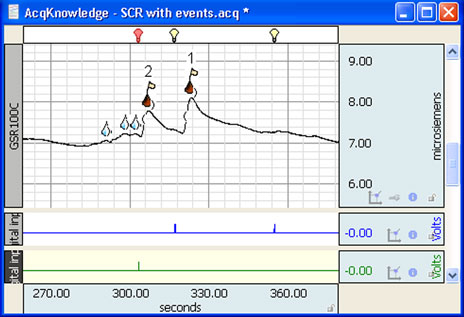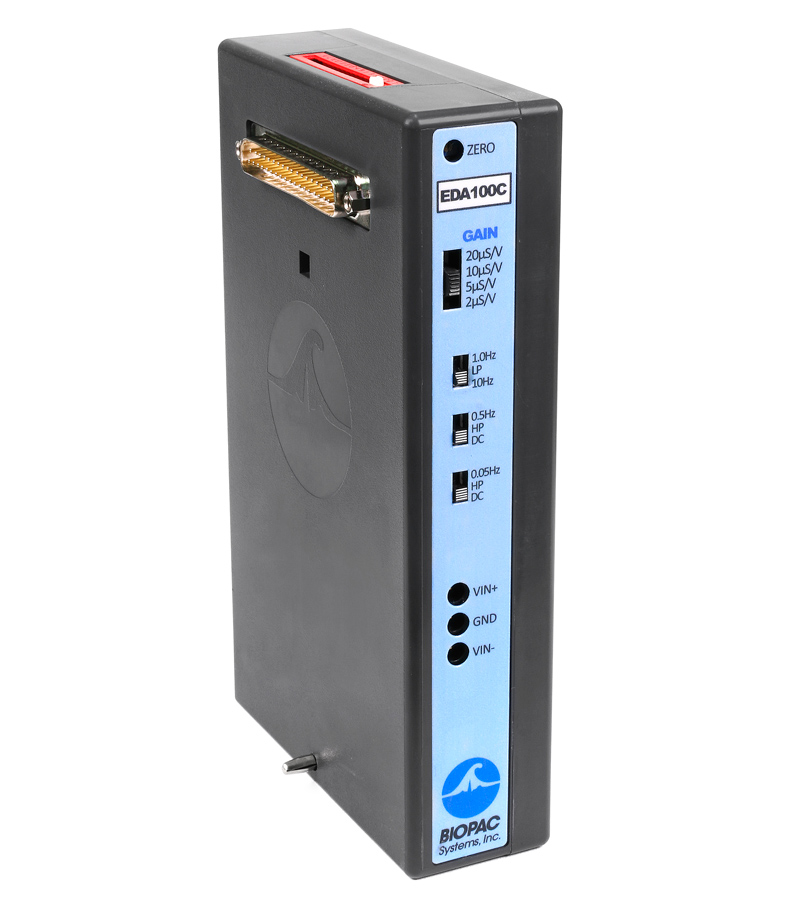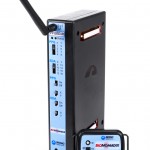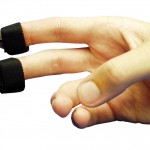
AcqKnowledge software includes a fully automated electrodermal response scoring tool that locates skin conductance responses, visually identifies them in the record and measures them. It also automates event related potentials (ERP) analysis by locating the onset of the stimuli and identifying a valid SCR.
Use the Focus Areas analysis tool for targeted EDA/GSR Analysis. Focus Areas allow the user to specify and mark areas of interest in the data and then run automated analysis routines or the cycle detector specifically on the Focus Areas instead of the entire data file.
See Applications > Psychophysiology for further analysis information and advanced features.
Each EDA100C amplifier requires one set of the following electrode combinations:
- 2 x LEAD110A Electrode Leads (recommended)
- 2 x EL507 disposable Electrodermal Electrodes (recommended)
or
- 1 x TSD203 Ag-AgCl Skin Conductance Transducer
- 1 x GEL101 Electrodermal Gel
or
- 2 x EL258 Ag-AgCl Lead Electrodes
- 1 x ADD208 Adhesive Disks
- 1 GEL101 Electrodermal Gel
Usage Recommendations
When using EL507 wait 5 minutes (minimum) before starting to record data. When using GEL101 it is important that the gel has a chance to be absorbed and make good contact before recording begins. Accordingly:
- Apply GEL101 to the skin at the point of electrode contact and rub it in.
- Fill the TSD203 electrode cavity with GEL101.
- Attach the TSD203 electrode to the subject.
- Wait 5 minutes (minimum) before starting to record data.
Calibration
To set up AcqKnowledge to record skin conductance directly, perform the following:
Lower frequency response at DC
In the scaling window, set the input voltages so they map to the DC conductance ranges indicated by the sensitivity setting. For example, if the EDA100C is set to a Gain of 5 µmho/V, then 0 V will map to 0 µmhos or infinite resistance and 1 V will map to 5 µmho or 200 kΩ.
Lower frequency response at 0.05 Hz
In the scaling window, set the input voltages so they map to the 0.05 Hz conductance ranges indicated by the sensitivity setting. For example if the EDA100C is set to a Gain of 5 µmho/V, then 0V will map to X µmhos and 1 V will map to (X+5) µmhos, where X is the mean conductance being recorded.
To verify the Gain setting of the EDA100C:
- Calibrate AcqKnowledgeas detailed above for lower frequency response at DC.
- Place the lower frequency response to DC.
- Set the Gain switch on the EDA100C to 5 µmho/V.
- Perform measurement with electrodes disconnected.
- AcqKnowledge should produce a reading of 0 µmho.
- Insulate a 100 kΩ resistor and place it from electrode pad to electrode pad (resistor must be insulated from fingers).
- Perform measurement with electrode-resistor setup.
- AcqKnowledge should produce a reading of 10 µmho.
EDA “Electrodermal Activity” is also known as GSR “Galvanic Skin Response.” Use BIOPAC Electrodermal Activety (EDA) hardware to record Galvanic Skin Response (GSR) Data.
Product Family
Product Type
Product Options
MODULAR CONSTRUCTION
Amplifiers snap together for easy system configuration and re-configuration.
Intuitive, Elegant AcqKnowledge Software
Powerful automated analysis. Instantly & easily view, measure, analyze, transform, and report data.
Powerful MP160 Data Acquisition and Analysis System
Flexible, proven modular data acquisition and analysis system for life science research.









Stay Connected